Innovating Medical Technology with Artificial Intelligence
The rise of artificial intelligence (AI) has become one of the most talked about emerging technology trends in various industries. It has also played an increasingly important role throughout various aspects of our lives, whether it be the machines in a factory or smart home devices under our roofs. AI has been used to improve the medical outcome of patients. The medical world has always been data-driven, yet now it is more intelligent than ever. AI helps provide quick and accurate assessments of diseases and allows doctors to offer the best treatment plans. Its use has expanded into the many areas of patient care including diagnostic radiology.
A key enabler for the advances promised through the increased use of AI is the availability of high-quality displays and advanced embedded systems with great, secured communication capabilities to generate the images, process them and transfer complex data to the hospital server for further evaluation and storage of medical records. The computer that controls the operation must be able to host and run complex AI software to provide radiologists with immediate and accurate results.
This article will focus on how AI and its building blocks are impacting current medical practices with its increasing popularity in the areas of medical imaging and radiology, as well as saving lives.
How AI Computer Technology can Help Improve Medical Practice
 AI software and its computer hardware building blocks, together, can provide enhanced visualization of affected areas shown on the images taken and segment them to provide analysis of each region. It can flag anomalies in radiology results and allow doctors to make their conclusions based on AI-supported data. This advanced intelligent technology can rank severity of potential diseases so that radiologists can prioritize and offer expedited care and treatments. It can also help improve the speed of clinical workflow, allowing doctors to share, collaborate and consult with their peers through the secured cloud access.
AI software and its computer hardware building blocks, together, can provide enhanced visualization of affected areas shown on the images taken and segment them to provide analysis of each region. It can flag anomalies in radiology results and allow doctors to make their conclusions based on AI-supported data. This advanced intelligent technology can rank severity of potential diseases so that radiologists can prioritize and offer expedited care and treatments. It can also help improve the speed of clinical workflow, allowing doctors to share, collaborate and consult with their peers through the secured cloud access.
For example, during a radiology process, advanced computer hardware integrated into the imaging device is used to support the job of an AI interface. The system is used to calculate results, from the large number of images captured and additional data from the patient’s record. Based on these various sources and inputs, the AI system recognizes and develops evaluation criteria for the most common images and data points, which the system then designates as “normal.” From this basis, the system can determine where abnormalities exist and classify them. The system can also trace common links between images and data points to define relationships. This can help doctors arrive at a well-based diagnosis quickly, and with the help of AI data, they can develop highly personalized and best courses of treatment for specific patients.
Another example of how these technologies can improve medical procedures is the reduced use of tissue samples in diagnoses. A diagnosis may still rely on physical tissue samples from biopsies, but as image quality and detail improve, the need for analyzing physical samples will decrease. Rather than evaluating a physical slice of tissue under a microscope, a diagnosis may rely on the same tissue shown as an image derived from a radiology scan. The advantages include the reduced risk from biopsies (which involve removing tissue from a patient’s body for analysis) and possible infection, and allows the ability to look at other tissues without requiring a new tissue sample.
Current Areas of AI in Medical Imaging Use
AI can help enhance viewing of medical images, dissect each with multimodality based on deep learning to provide a much clearer analysis and look into the patient’s affected organs. It can help analyze cardiac images with a variety of ways – from a 2D plane, 3D Cine and 4D flow. All are done in a high speed of acquisition and accuracy. AI provides higher precision in detecting and tracking lung abnormalities. It can significantly assist doctors and radiologists in the visualization of liver lesions and provide volumetric and longitudinal segmentation with exceptional focus and intelligence. It can also optimize mammography reading and offer a more effective outcome with AI-recommended focused areas of study.
How AI Enhances Doctor’s Workflows, Patient’s Diagnoses and Treatments
 In the following case, a heart patient may arrive at a hospital with an irregular heart beat and see a cardiologist. When the doctor enters the patient’s identity into the AI system, the AI module accesses heart-related images and data from the patient’s electronic medical record (EMR). Depending on how the system is programmed and whether the patient has a history of heart disease, the doctor may see thumbnails, descriptive text and summaries of any past and current treatments. In addition, there would be links to other medical issues the patient may have had and records of any other treatments.
In the following case, a heart patient may arrive at a hospital with an irregular heart beat and see a cardiologist. When the doctor enters the patient’s identity into the AI system, the AI module accesses heart-related images and data from the patient’s electronic medical record (EMR). Depending on how the system is programmed and whether the patient has a history of heart disease, the doctor may see thumbnails, descriptive text and summaries of any past and current treatments. In addition, there would be links to other medical issues the patient may have had and records of any other treatments.
The doctor can order an EKG and review both new test results and existing data in the patient record to quickly determine what is relevant for the case at hand and call up the corresponding images and data from the patient’s file or order new scans. The AI system displays the images and all linked data the system considers important according to the case histories it has evaluated. At this point, if a diagnosis is clear, the AI system may suggest courses of treatment that have been effective for the diagnosed problem in the past. The doctor may choose from the proposed course and adjust treatment for the patient at hand, or determine that a new and different course of treatment is appropriate. AI helps the medical professionals make the right decisions quickly and assist in narrowing down and simplifying comprehensive data with many possibilities to highly focused diagnoses and treatment options. The resulting outcome improves patient care and saves more lives.
Building Blocks of AI in Medical Imaging
 The use of AI in medical imaging relies upon the integration of software and hardware such as medical-grade display panels and embedded systems with high computing capabilities into medical devices that capture and process images. Radiology images such as those obtained from CT scanners, X-rays and MRI machines can be displayed in different formats – from 2D to 4D with multi-modality for better analysis, with different coloring and higher resolutions than ever before. Once created, the images can be analyzed to yield insights into possible treatments and predicting treatment outcomes.
The use of AI in medical imaging relies upon the integration of software and hardware such as medical-grade display panels and embedded systems with high computing capabilities into medical devices that capture and process images. Radiology images such as those obtained from CT scanners, X-rays and MRI machines can be displayed in different formats – from 2D to 4D with multi-modality for better analysis, with different coloring and higher resolutions than ever before. Once created, the images can be analyzed to yield insights into possible treatments and predicting treatment outcomes.
In order to accomplish this, an AI-integrated computer system with high processing power is required to access all the information quickly and efficiently. It would also require connectivity options for real-time access to a patient’s EMR, which would be stored in a database. Medical-certified touch panel computers/display monitors must be integrated into the device to provide the basis for medical imaging operations – from acquiring images and retrieving data to analyzing results and offering possible outcomes through the use of AI software and its deep learning capacity.
Creating and Displaying Images
2D-4D images from radiology devices are a key component of AI-supported medicine because they are rich in information that AI can help filter, segment and display in a structured way. For example, for a scan showing a tumor, AI can detect the abnormal cell structures and highlight them in the displayed image or zoom in on the area in question as well as offering a model of the dissected region for better visualization of the problem. The doctor can have an easier time narrowing down diagnostic possibilities and focusing on the affected area while examining the rest of the image if more context is needed or order additional scans.
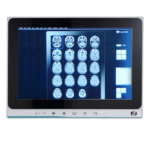 Using AI in this way relies on two processes. The medical-grade touch panel computer must be able to process and create the images from the radiology inputs in high speed, and access a patient’s record quickly and accurately while allowing computing power for the AI’s recommendations. The images must be displayed in high resolution with excellent color contrast.
Using AI in this way relies on two processes. The medical-grade touch panel computer must be able to process and create the images from the radiology inputs in high speed, and access a patient’s record quickly and accurately while allowing computing power for the AI’s recommendations. The images must be displayed in high resolution with excellent color contrast.
Axiomtek offers fanless medical-grade touch panel computers that can handle medical image displays for AI systems. They offer UL60601-1/ EN60601-1, CE and FCC Class B certifications to ensure operational reliability in the medical industry. The MPC fanless touch panel computer series features high resolution displays in multiple sizes. They feature IP65 front bezels and IPX1 full enclosures to protect against water and dust. The touch panel computers offer adequate processing powers required for the image generation tasks. The units have multiple I/O ports for peripherals like RFID scanners, Ethernet connectivity and a flexible data storage capacity. Expansion slots for special functions and RS-232 ports are also available.
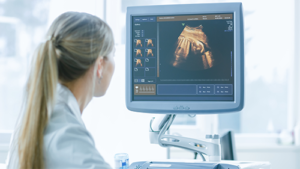 The Axiomtek touch panel computer can take inputs from radiology and store the complex images while displaying slices, 3D-4D models, different views and high resolution details. The integrated memory and processing power allow the rapid assembly and display of different views as needed. Speed and good imaging accuracy are essential for a quick and reliable diagnosis.
The Axiomtek touch panel computer can take inputs from radiology and store the complex images while displaying slices, 3D-4D models, different views and high resolution details. The integrated memory and processing power allow the rapid assembly and display of different views as needed. Speed and good imaging accuracy are essential for a quick and reliable diagnosis.
If a display monitor is used in place of a touch panel computer, integration with a high performance embedded computer is required to carry out the medical imaging process. High performance CPU, ample processing memory and rich communication capabilities are key to the building block of the AI medical imaging device. Communication interfaces have become the key success factors in our IoT-driven world, i.e., Ethernet and/or WiFi interfaces are a must for transferring information captured and retrieving data in the patient’s EMR for AI processing. The data can be safely transferred to the clouds for storage or further access. In many cases, real-time OS are installed on the embedded system to offer real-time capabilities for quicker analysis.
A Closer Look at Images and Data Processing
Images and the corresponding data are either new, from a current visit and from new scans, or from patient files in the patient EMR. New images can be displayed right away and stored as structured data so they are available for future reference. AI can access the structured data and display the most relevant aspects to help a doctor’s decision-making process. This is especially important for AI functions such as diagnostic help, the development of therapy plans and for image interpretation.
The structured data can combine with AI to automate routine tasks. Alerts, reminders and prescription refills can be generated automatically based on an AI analysis of the patient files. For patients undergoing regular testing, AI can detect a change in the patient’s condition and generate an appropriate response that could range from a note for the patient to an alert for the doctor. Follow-ups, scheduling and instructions could be handled by AI, freeing both doctor and patient from routine tasks while ensuring greater accuracy in keeping to the suggested treatment schedule.
Axiomtek’s Industrial Computer Solutions for Medical Imaging Device Integration
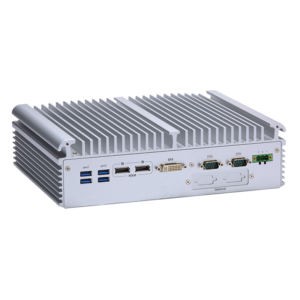 Axiomtek’s solutions for medical device OEMs/ODMs range from motherboards, embedded systems, EN-/UL-certified medical touch panel computers, DIN-rail gateway computer systems and many more. In addition to the MPC product line that was discussed in the Creating and Displaying Images section, Axiomtek has been developing and delivering many high quality industrial computer solutions to medical device manufacturers for more than 27 years. Axiomtek manufactures a wide range of industrial embedded motherboards that can be integrated into a medical imaging device and hosting of AI software. They come in a full range of form factors with various features suitable for integration into a wide variety of medical devices. These motherboards offer scalable processors, versatility and easy-to-integrate designs. Axiomtek’s design engineering service team has helped many medical device manufacturers customize their choices of motherboards to suit their application needs. The expert team has proven to deliver great value and high level of personalized services to medical product OEM/ODM customers and is a key advantage over the company’s competitors. Axiomtek’s product lines include high quality fanless embedded systems for integration with medical device OEM/ODM projects. The eBox series is comprised of various expandable, customizable embedded systems with scalable processing powers and rugged extruded aluminum cases. They have extensive useful features such as COM, USB and Ethernet communication ports, as well as VGA and HDMI display ports. Some models feature Power over Ethernet (PoE) ports, which can be used for connections with cameras. With expansion slots and flexible disc drive arrangements, they can deliver the storage and computer capabilities needed for medical image and data processing. The ICO DIN-rail gateway embedded system series feature fanless units with robust IP40-rated designs and wide power input ranges. The product series offer rich I/O options such as GbE LAN, COM, USB and DIO ports. They are scalable and cost-effective systems that can operate within a wide range of temperatures and allow wireless connectivity through expansion slots.
Axiomtek’s solutions for medical device OEMs/ODMs range from motherboards, embedded systems, EN-/UL-certified medical touch panel computers, DIN-rail gateway computer systems and many more. In addition to the MPC product line that was discussed in the Creating and Displaying Images section, Axiomtek has been developing and delivering many high quality industrial computer solutions to medical device manufacturers for more than 27 years. Axiomtek manufactures a wide range of industrial embedded motherboards that can be integrated into a medical imaging device and hosting of AI software. They come in a full range of form factors with various features suitable for integration into a wide variety of medical devices. These motherboards offer scalable processors, versatility and easy-to-integrate designs. Axiomtek’s design engineering service team has helped many medical device manufacturers customize their choices of motherboards to suit their application needs. The expert team has proven to deliver great value and high level of personalized services to medical product OEM/ODM customers and is a key advantage over the company’s competitors. Axiomtek’s product lines include high quality fanless embedded systems for integration with medical device OEM/ODM projects. The eBox series is comprised of various expandable, customizable embedded systems with scalable processing powers and rugged extruded aluminum cases. They have extensive useful features such as COM, USB and Ethernet communication ports, as well as VGA and HDMI display ports. Some models feature Power over Ethernet (PoE) ports, which can be used for connections with cameras. With expansion slots and flexible disc drive arrangements, they can deliver the storage and computer capabilities needed for medical image and data processing. The ICO DIN-rail gateway embedded system series feature fanless units with robust IP40-rated designs and wide power input ranges. The product series offer rich I/O options such as GbE LAN, COM, USB and DIO ports. They are scalable and cost-effective systems that can operate within a wide range of temperatures and allow wireless connectivity through expansion slots.
AI Implementation Today and Tomorrow
 The implementation of AI medical imaging systems is increasing and has become a growing trend in the medical industry. The adoption of AI-assisted medical devices will eventually become widespread and will change the way medical professionals operate as well as the quality of patient care. The areas in which AI technology can make an immediate impact include the following:
The implementation of AI medical imaging systems is increasing and has become a growing trend in the medical industry. The adoption of AI-assisted medical devices will eventually become widespread and will change the way medical professionals operate as well as the quality of patient care. The areas in which AI technology can make an immediate impact include the following:
- Diagnosis – improved imaging, filtering of relevant images and highlighting problem areas.
- Treatment – presenting relevant patient history, possible treatments, treatment effectiveness and possible risks.
- Scheduling – planning tests, scheduling follow-up visits, monitoring medicine consumption and scheduling patient therapy.
- Notification – alerts for changes in patient condition, reminders and alarms for specific events.
Successful and effective implementation of AI in the medical field will save lives, improve the patient experience as well as help medical professionals make quick and well-based decisions. AI capability relies on advancement in the capabilities of hardware such as MPCs, embedded motherboards and fanless embedded systems, which are key building blocks for medical devices. Axiomtek’s high performance industrial computer products can take on the functions available today and will continue to innovate and offer advanced and highly reliable industrial computer solutions as AI development continues to evolve.
Product Showcase
MANO520 – High Performance Mini-ITX Motherboard

- Advanced LGA1151 8th generation Intel® Core™ i7/i5/i3 processor with option of Intel® H310 chipset or Q370 chipset
- Feature-rich with two GbE LANs, four COMs, four USB 3.0, four USB 2.0, two DisplayPort++, one HDMI and one LVDS
- Expandable with one PCIe x 16 and one M.2 Key E
- Ample storage with three SATA-600 and one mSATA
CAPA315 – Compact, Feature-Rich 3.5-Inch Embedded Motherboard

- Scalable CPU options with Celeron® processor N3350 or Intel® Pentium® processor N4200
- Feature-rich with two GbE LANs, four COMs, four USB 3.0, two USB 2.0, two HDMI and one eDP
- Expandable with one PCIe Mini Card slot
- Features one DDR3L SO-DIMM for up to 8GB of system memory
eBOX671-521-FL – Advanced, Feature-Rich Fanless Embedded System
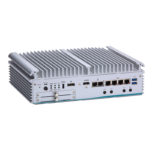
- Advanced LGA1151 8th generation Intel® Core™ i7/i5/i3 processor with option of Intel® H310 chipset or Q370 chipset
- Feature-rich with two GbE LANs, four GbE PoE, two COMs, four USB 3.1 Gen2, two USB 3.1 Gen1, two optional DisplayPorts via MXM module, one HDMI, one DisplayPort, one DVI-I, four SMA-type antenna connector and one flexible I/O window
- Features dual swappable 2.5″ SATA HDD drive bay
- Supports AXView 2.0 intelligent remote monitoring software for IIoT
ICO300-83B – Robust DIN-Rail Fanless Embedded System
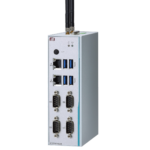
- Scalable CPU options with Intel® Celeron® processor N3350 or Pentium® processor N4200
- Feature-rich with two GbE LANs, choice of two or four isolated COMs, four USB 3.0 and optional 8-bit programmable DIO for IoT gateway applications
- Features OVP, UVP, OCP and RPP power protection design
- Supports AXView 2.0 intelligent remote monitoring software for IIoT
MPC152-845 – Rugged 15-Inch Medical Touch Panel Computer
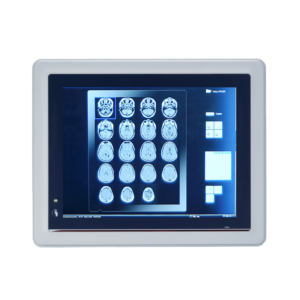
- EN 60601-1-, CE- and FCC-certified fanless PC with dual-core Intel® Celeron® Processor N3060
- XGA TFT LCD display with a resistive touchscreen and 420 nits of brightness
- Equipped with IP65-rated front bezel to prevent damage from dust and liquid spillage
- Two PCIe Mini Card slots available for RFID, 3G, Bluetooth or Wi-Fi connection
MPC102-845 – Expandable, Compact 10.1-Inch Medical Touch Panel Computer

- EN 60601-1-, CE- and FCC-certified fanless PC with dual-core Intel® Celeron® Processor N3060
- XGA TFT LCD with LED backlight and 350 nits of brightness
- IP65, NEMA 4 rugged front bezel to protect against liquid spillage and dust
- One full-size PCIe Mini Card slot with mSATA and one full-size PCIe Mini Card slot with SIM available for RFID, 3G, Bluetooth or Wi-Fi connection
Contact us via email at medicalsolutions@axiomtek.com, or call 1-888-GO-AXIOM (1-888-462-9466) for more information.

